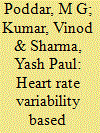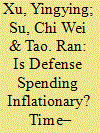| Srl | Item |
| 1 |
ID:
136044


|
|
|
|
|
| Summary/Abstract |
The aim of this study is to analyse and compare the heart rate variability (HRV) of normal and hypertension cases using time domain, frequency domain, and nonlinear methods. For short term HRV analysis, a five-minute electrocardiogram (ECG) of 57 normal and 56 hypertension subjects were recorded with prior verification of their clinical status by a cardiologist. Most time domain features of hypertension cases have clearly reduced values over normal subjects, frequency domain features, like power in different spectral bands, also have the distinguishable decreased values, whereas sympathovagal balance has clear edge over hypertension cases than normal cases. Nonlinear parameters of Poincare plot, approximate entropy and sample entropy, have higher values in normal cases when compared with hypertension cases. Support vector machine-based binary system classifies these two classes with 100 per cent accuracy and 100 per cent sensitivity when all time domain, frequency domain, and nonlinear features were used. It may work as a better predictor for in patients with hypertension.
|
|
|
|
|
|
|
|
|
|
|
|
|
|
|
|
| 2 |
ID:
171075


|
|
|
|
|
| Summary/Abstract |
This study examines the nexus between the defense spending growth rate and inflation to test whether defense spending is inflationary in China, particularly in times of peace. Using wavelet analysis, we find that the linkage between the defense spending growth rate and inflation changes over time and across frequencies. We provide evidence supporting negative leading effects of inflation on the defense spending growth rate in certain periods across various frequencies. The results illustrate that the relationship is stronger at the short- to medium-term horizon of less than eight years than it is in the long term. No positive leading effect of defense spending on inflation is demonstrated, showing that defense spending is not inflationary in China. The results indicate that inflation lowers the defense spending growth rate at short and medium scales, particularly in peace time. This study provides new insights into the nexus between defense spending and inflation and emphasizes that such a correlation has time and frequency features. Meanwhile, given that there is little evidence supporting the idea that defense spending is inflationary, a moderate increase in defense spending will not damage price stability in China.
|
|
|
|
|
|
|
|
|
|
|
|
|
|
|
|